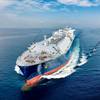By Capt. Jean Roberts, Carrier Strike Group 8 Public Affairs
Four Canadian ships completed training with the George Washington Carrier Strike (GW CSG) Group Feb. 29 following the completion of their Task Group Exercise 02-08 while at sea off the coast of Florida.
The destroyer HMCS Iroquois (DDG 280), frigates HMCS Ville de Quebec (FFH 332), HMCS St. John's (FFH 340), oil replenishment ship HMCS Preserver (AOR 510), and the submarine HMCS Corner Brook (SSK-878) trained cooperatively with USS George Washington (CVN 73), USS Farragut (DDG-99), USS Boone (FFG-28) and USS Kauffman (FFG-59).
Two haze-gray ships, Farragut and Boone, slipped out of the Mayport, Fla., basin to join four others of a slightly different color.
"It looks like a weird color to us, but those Canadian ships are nearly invisible in the fog of their home waters where they hone their amazing ship driving skills," said Lt. Cmdr. Eric Dukat, future operations and exercise planner for Carrier Strike Group (CSG) 8.
It was a seamless rendezvous when Farragut and Boone joined the Canadian Task Group 301.1 for maritime security exercises off the coast of Florida.
Dukat explained, "I've never seen voice communications and maritime picture data links work right out of the barn like that with our own ships, let alone with those from a partner nation."
Commodore R. A. Davidson, commander of the task group, and his ships Iroquois, Ville de Quebec, St. John's, Preserver, and Corner Brook were conducting exercises preparing them for maritime security deployments around the world.
"In all, I believe this to have been an excellent testament to the progress we are making in achieving smooth interoperability between our respective navies and clearly illustrates the value, both in training and for operation, in achieving that goal," he said.
The two U.S. ships, Farragut and Boone, from GW CSG were the local vanguard to the combined warfare training events that were to follow when the two task groups joined at sea days later.
Meanwhile, to the north off the colder coast of Virginia, George Washington was conducting flight operations to get Carrier Air Wing 17 settled in to their new home on board.
In the planning cells of Destroyer Squadron (DESRON) 40, final touches were placed on the Maritime Interdiction Operations (MIO) training. MIOs are cornerstone skills for Maritime Security Operations (MSO) that help nations control their own coastal waters as a way of thwarting illegal enterprises.
Lt. Carlos Recio of the Armada de Argentina is one of the DESRON's core MIO planners. As an assigned exchange officer from the Argentinean Navy, Recio brought both regional and professional expertise to this unique DESRON assigned to the U.S. Southern Command area of focus.
"[Lt.] Recio is helping us plan and train to know what we will be executing with his navy off the coast of Porto Belgrano (Argentina) in just a few months," said Dukat, referring to the GW CSG participation in Partnership of the Americas 2008.
Days later, 80 miles off the coast of Florida, the combined task groups were deeply into their multi-warfare training. The American ships had completed their submarine warfare training with both an American nuclear sub and the Canadian diesel sub.
The air wing was flying defensive missions over the force and the Canadian ships were preparing to escort a humanitarian aid vessel into a simulated port that had a simulated terrorist threat made against it.
As the helicopter support was on its way to provide small boat attack defense to the Canadian task group, Recio was on board GW briefing the strike group commander, Rear Adm. Phil Cullom, and his warfare commanders on the MIO operations taking place in nearby coastal waters.
The focus of the brief was on highly trained skills, effective communications, and safe mission accomplishment.
"[Lt.] Recio was fully integrated into the operations of the DESRON 40 staff. He truly brought the first-hand experience with him to advise and make recommendations on the best ways to operate with our partner navies in the area of responsibility," said Capt. Randy Snyder, commander, DESRON 40.
Cullom echoed the importance of their cooperative training to the ultimate goal of achieving security in the region.
"When we conduct maritime security training with our partners to the north, such as Canada, and partners to the south, which in this case, was Argentina, we add to hemispheric solidarity and make us all more secure, stable, and prosperous," said Cullom. "Together, as equals, we must continue to learn much from each other. Just such an opportunity begins shortly for the strike group when it heads to South America in April to participate in Partnership of the Americas 2008, a yearly exercise that provides interoperability training opportunities for air, surface, and subsurface branches of militaries of various South American Partners."
Subscribe for
Maritime Reporter E-News
Maritime Reporter E-News is the maritime industry's largest circulation and most authoritative ENews Service, delivered to your Email five times per week










